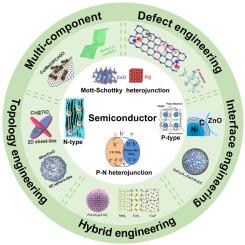Semiconductor-based electromagnetic wave absorption materials: Review and perspectives
IF 14.3
1区 材料科学
Q1 MATERIALS SCIENCE, MULTIDISCIPLINARY
引用次数: 0
Abstract
The diverse charge and band structures of semiconductor materials have necessitated the development of semiconductor-based electromagnetic wave absorption materials (SEMAs). This review provides a comprehensive analysis of the latest advancements in SEMAs of various semiconductor categories, including but not limited to n-type semiconductors, p-type semiconductors, Mott-Schottky heterojunctions, p–n heterojunctions, etc. Furthermore, the review summarizes strategies for optimizing absorption performance through defect engineering, interface engineering, hybrid engineering, topology engineering, and multi-component optimization. It also delves into the intricate relationship between semiconductor structure, electromagnetic properties, and absorption performance. Finally, current challenges and future research directions for SEMAs are proposed, emphasizing the need for the optimization of new structural materials, in-depth exploration of mechanisms, intelligent design and control, practical applications, and industrialization. This review aims to offer new perspectives for the development of next-generation SEMAs, facilitating fundamental breakthroughs in the mechanistic understanding of electromagnetic wave absorption in semiconductors and advancing diverse applications in military stealth, electromagnetic protection, and wireless communication.

半导体基电磁波吸收材料:综述与展望
半导体材料的电荷和能带结构的多样性使得基于半导体的电磁波吸收材料(SEMAs)的发展成为必要。本文综合分析了各种半导体类别SEMAs的最新进展,包括但不限于n型半导体、p型半导体、Mott-Schottky异质结、pn异质结等。此外,综述了通过缺陷工程、界面工程、混合工程、拓扑工程和多组分优化来优化吸收性能的策略。它还深入研究了半导体结构、电磁特性和吸收性能之间的复杂关系。最后,提出了SEMAs目前面临的挑战和未来的研究方向,强调需要优化新型结构材料、深入探索机理、智能设计和控制、实际应用和产业化。本文综述旨在为下一代SEMAs的发展提供新的视角,促进对半导体中电磁波吸收机理的理解取得根本性突破,并推进其在军事隐身、电磁保护和无线通信中的多种应用。
本文章由计算机程序翻译,如有差异,请以英文原文为准。
求助全文
约1分钟内获得全文
求助全文
来源期刊

Journal of Materials Science & Technology
工程技术-材料科学:综合
CiteScore
20.00
自引率
11.00%
发文量
995
审稿时长
13 days
期刊介绍:
Journal of Materials Science & Technology strives to promote global collaboration in the field of materials science and technology. It primarily publishes original research papers, invited review articles, letters, research notes, and summaries of scientific achievements. The journal covers a wide range of materials science and technology topics, including metallic materials, inorganic nonmetallic materials, and composite materials.
 求助内容:
求助内容: 应助结果提醒方式:
应助结果提醒方式:


